Research - (2022) Volume 12, Issue 7
Phytochemical study of two medicinal plants (Rosmarinus officinalis and Anthémis nobili) from the Haddada region (El Tarf-Algeria)
S. Mouissi1*, S. Bouchelaghem2 and N. Djabali2Abstract
Medicinal plants are still the weak source of active principles known by their therapeutic properties, which leads us to the conservation of the biodiversity of local plant species. To this end we have carried out a phytochemical screening of two medicinal plants most used in the region of El Tarf. The present work was carried out in the laboratory of chemistry at the University of El Tarf in order to realize phytochemical analyses of some active principles of two medicinal plants, the Rosemary family of Lamiaceae (Rosmarinus officinalis) and the Chamomile family of Asteraceae (Anthémis nobili) are aromatic plants still used in the traditional medicine of many countries as antiseptic, antiviral, antispasmodic, stomatal, expectorant, in aromatic or in infusion. The results obtained show that the phytochemical screening revealed the presence of alkaloids, flavonoids, saponins, volatile oils, tannins and anthocyanins.
Keywords
Rosmarinus officinalis, Anthemis nobili, Medicinal plant, Active principles, Phytochemical screening.
Introduction
The history of aromatic and medicinal plants "A.M.P." is associated with the evolution of civilizations. In all regions of the world, the history of peoples shows that these plants have always occupied an important place in medicine, in the composition of perfumes and in culinary preparations (Belkacem, S, 2009). Herbal medicine is one of the oldest medicines in the world. It represents an interesting alternative to treat and cure without creating new diseases. Despite the phenomenal development of the pharmaceutical and chemical industry, popular interest in herbal medicine has never stopped evolving (Benguerba, A, 2008). Nowadays these two types of medication are found intimately linked since the molecular model of most of the drugs put on the market, have their origin in the plant (Ladu, G., Cubaiu, L., d'Hallewin, G., Pintore, G., Petretto, G.L., Venditti, T, 2015). In developing countries, between 70 and 95% of the population uses medicinal plants for primary care due to lack of access to prescribed drugs but also because plants have been shown to be really effective. It is estimated that at least 25% of all modern medicines are derived directly or indirectly from plants, through the application of modern technologies to traditional knowledge. (Sahi, L, 2016). In addition, the side effects induced by the drugs worry the users. They are turning to less aggressive treatments. It is estimated that 10 to 20% of hospitalizations are due to side effects of chemical drugs. (Benhouhou, S, 2015). Medicinal plants contain a large number of active molecules of multiple interests put to good use in industry, food, cosmetology and in dermopharmacy. (Menaceur, F, 2012). Among these molecules are coumarins, alkaloids, phenolic acids, tannins, lignans, terpenes and flavonoids (Benkiki, N, 2006). Flavonoids potentially possess biological, antinflammatory, anti-carcinogenic, antimicrobial and antioxidant activities. (Santos, R.D., Shetty, K., DaSilva Miglioranza, L.H, 2014). In Algeria the use of medicinal plants occupies an important place in the life of the population given the floristic wealth of our country. ( Zakarienė, G., Rokaitytė,A., Ramonaitė S,2015). Given this richness of the plant world, our work is interested in medicinal plants most used in the region of el tarf, including chamomile (Anthémis Nobili) and rosemary (Rosmarinus Officinalis L).to develop an experimental method in the laboratory allowing a phytochemical study of some active ingredients of our two plants. The choice of two of these plants is based on the one hand on the importance of its family "Lamiaceae" and on the other hand on its known and frequent traditional use among the populations studied.
Materials and Methods
Plant material
The studied species collected on a determined area in the same regions (Haddada) the forest of Haddada constitutes the prolongation of the wooded littoral zone of the extreme North-East of Algeria. It is limited to the North by Segleb, to the East by the Tunisian borders, to the West by the commune of Souarekh and to the South by the commune of El Aioun.
The following Table 1 shows the dates and locations of harvest.
| Species | Date of harvest | Location of harvest | Part harvested |
|---|---|---|---|
| Rosemary | 17/04/2021 | Haddada | Leaf, stem |
| Chamomile | 17/04/2021 | Haddada | Flower |
| Rosemary | 25/04/2021 | Haddada | Leaf, stem |
| Chamomile | 25/04/2021 | Haddada | Flower |
Table 1. Sampling characteristics.
Drying
The harvested plants must be dried in the shade, in well-ventilated places, protected from humidity and water, the drying control being done daily. The maximum temperature allowed for the drying of plants is 30 (Boumaza, D, 2011) and (Bruneton, J, 2009).
The conservation
After drying, the best way to preserve the dried plants is to place them in a thick original bag and store them away from light and humidity. In these conditions of conservation, the plants can keep all their properties until their analysis in the laboratory. (Mansour, S, 2015) and (Nogaret, A.S, 2003) and (. Solinas, V., Deiana, S., Gessa,C., Bazzoni,A.,Loddo, D, 1996).
Methodologies
The plant materials that will allow us a "phytochemical screening" test are coarsely ground in an electric mill. The powder of this material is submitted to a set of phytochemical tests: alkaloid test, flavonoid test, tannins, steroids....etc.
Phytochemical screening
Preparation of the infusion
2 grams of the dry matter are covered with 20ml of very hot or boiling water, after 3 to 6 minutes, or stir slightly and filter (Fig. 1).

Fig 1: Preparation of the infusion.
Volatile oils
Macerate 10 g of the leaf powder in 40ml of distilled water with constant stirring 30 ml extract is filtered. 2 ml of filtering medium is shaken with 0.1 ml of diluted NaOH and a small amount of diluted HCL. A white precipitate is formed with the volatile oils (Fig. 2).
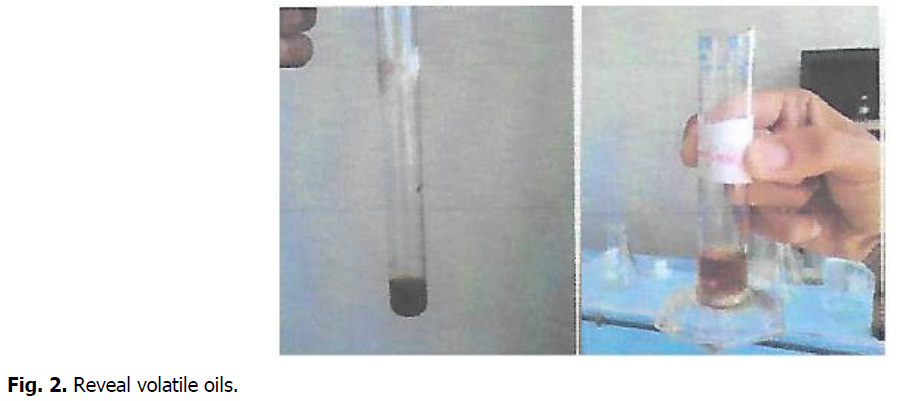
Fig 2: Reveal volatile oils.
Tannins
A portion of the 10% infusion is diluted with distilled water in a ratio of (1/4) and 3 drops of ferric chloride FeCl3 of 10% are added (Fig. 3).
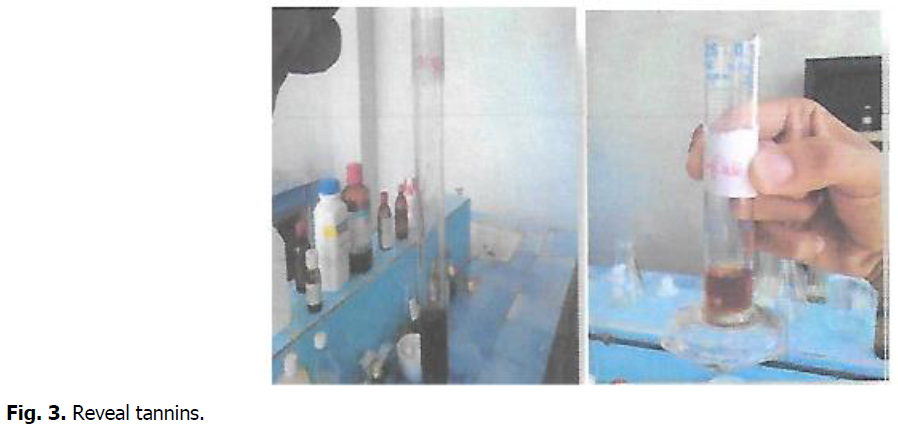
Fig 3: Reveal tannins.
Flavonoids
Macerate 10 g of the powder in 150 ml of HCL diluted at 1% for 24 hours, filter and proceed to the following test:
Take 10 ml of the filtrate, make it basic by adding NH4OH; the appearance of a light yellow color in the upper part of the test tube, indicates the presence of flavonoids (Fig. 4).
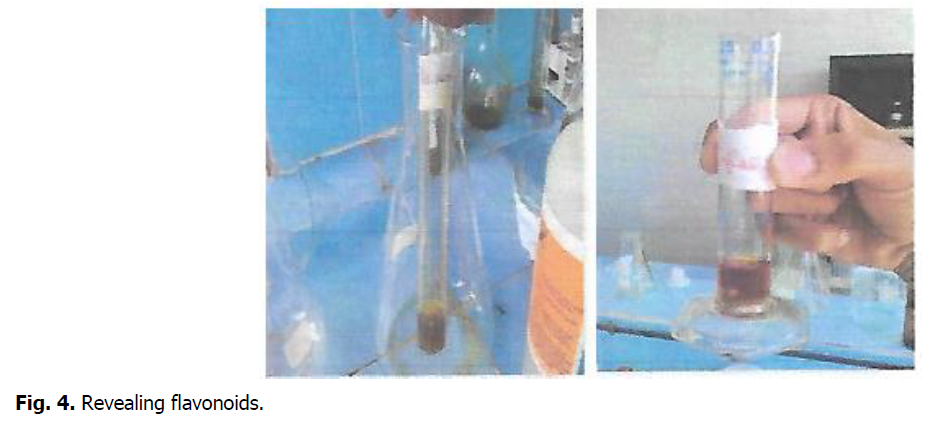
Fig 4: Revealing flavonoids.
Alkaloids
Macerate 5 g of the powder in 50 ml of 10% HCL, filter then add to the filter a few drops of Mayer's reagent. A white precipitate indicates the presence of alkaloids (Fig. 5).
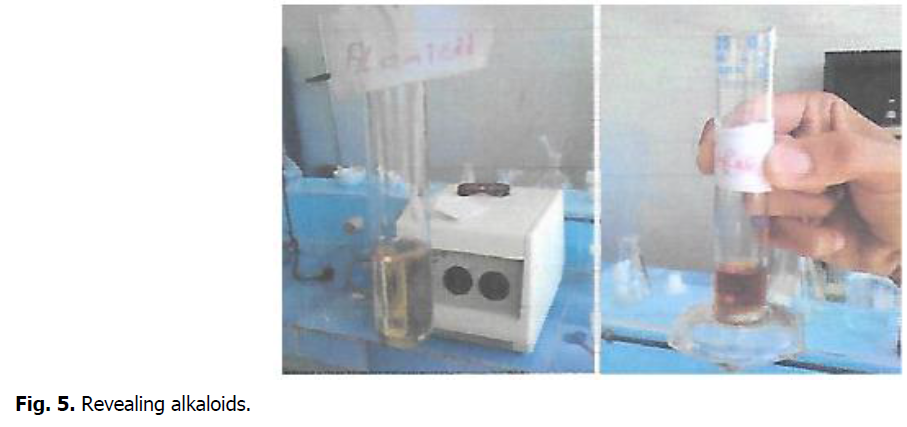
Fig 5: Revealing alkaloids.
Anthocyanins
Rest on the change of color of the infusion at 10% with change of PH. We add to the infusion some drop of pure HCL, we have a change of color, and then we add some drop of NH4OH. We have another change of color; this indicates the presence of anthocyanins (Fig. 6).
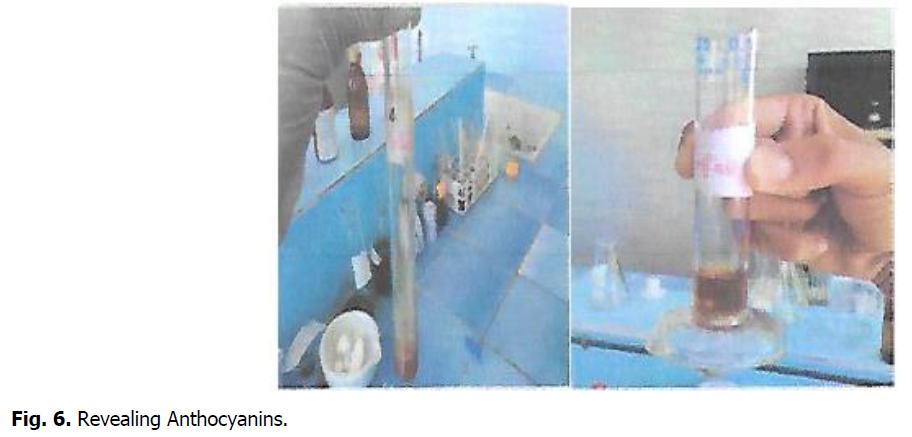
Fig 6: Revealing Anthocyanins.
Leuco-anthocyanins
We heat 5 ml of the 10% infusion with 4 ml (ethanol/pure HCl 3/1) in a 50°C water bath for a few minutes. A cherry red color indicates the presence of leuco-anthocyanins (Fig. 7).
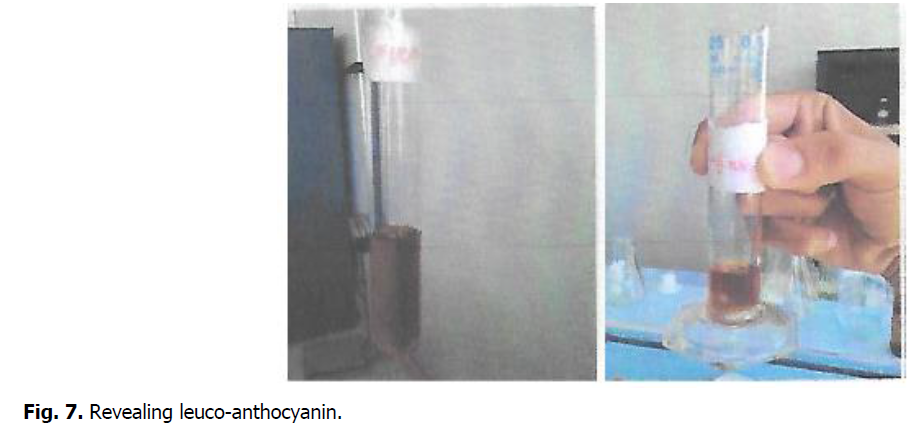
Fig 7: Revealing leuco-anthocyanin.
Saponins
One gram of the dry powder is weighed into a flask into which 10 ml of distilled water is added and boiled for 5 minutes. The mixture is filtered; 2.5 ml of the filtrate is added to 10 ml of distilled water in a test tube. The test tube is shaken vigorously for about 30 seconds and then left to stand for half an hour. Foaming foam reveals the presence of saponins.
Coumarins
One gram of the material is placed in a tube, in the presence of a few drops of water, the tube is covered with paper soaked in diluted NaOH and brought to boil. Afterwards a drop of water is taken and put on TLC plate. Any yellow fluorescence shows the presence of coumarins after examination under UV2.
The cardinolides
Macerate 1 g of the powder in a 20 ml of distilled water and filter, take 10 ml of the filtering, extract it with a mixture of chloroform CHCI3 and ethanol C2H5OH. Evaporate the organic phase and dissolve the precipitate in 3 ml of acetic acid CH3COOH, add a few drops of FeCI3 followed by 1 ml of concentrated H2SO4 on the wall of the test tube, the appearance of a green-blue color in the acid phase indicates the presence of cardinolides.
Terpenes and sterols
Macerate 1g of the powder in 20ml of ether for 24 hours, filtered then evaporated, the residue obtained is dissolved in anhydrous. The addition of pure sulfuric acid develops, in the presence of sterol or terpene products, a mauve coloration turning to green.
Results
The results obtained are grouped in the following Table 2 and 3:
| Active ingredients | Specific reagents | Results |
|---|---|---|
| Saponins | NaOH | Positive |
| Volatile oils | NaOH+HCL | Positive |
| Tannins | FeCl3 | Positive |
| Coumarins | NaOH | Positive |
| Flavonoids | HCL+NH4OH | Positive |
| Alkaloids | Mayer's reagents | Positive |
| Anthocyanins | HCL+NH4OH | Positive |
| Leuco-anthocyanins | Ethanol | Positive |
| Terpenes and sterols | Ether | Positive |
| Free quinones | Petrol ether | Positive |
| Cardinolids | CHCl3+H2H5OH+CH3COOH+FeCl3+H2SO4 | Positive |
Table 2. Results obtained from "phytochemical screening" tests of the rosemary plant.
| Active ingredients | Specific reagents | Results |
|---|---|---|
| Saponins | NaOH | Negative |
| Volatile oils | NaOH+HCL | Positive |
| Tannins | FeCl3 | Positive |
| Coumarins | NaOH | Positive |
| Flavonoids | HCL+NH4OH | Positive |
| Alkaloids | Mayer's reagents | Positive |
| Anthocyanins | HCL+NH4OH | Positive |
| Leuco-anthocyanins | Ethanol | Positive |
| Terpenes and sterols | Ether | Positive |
| Free quinones | Petrol ether | Positive |
| Cardinolids | CHCl3+H2H5OH+CH3COOH+FeCl3+H2SO4 | Positive |
Table 3. Results obtained from phytochemical screening tests of the chamomile plant.
The positive test confirms the presence of active ingredients for both plants. Concerning the Rosemary the active ingredients are located in the leaves while the Chamomile contains several active ingredients in the flowers.
Discussion
Through the ethnobotanical study carried out among the population of the study area, it appears that there is a diversity of practices, as for the species, treated symptoms, parts used, doses of preparation and mode of use. There is also a diversity of information concerning the people surveyed; age class, profession, sex, family situation and level of education. (Rosua, A, 1987) and (O.M.S, 2000) and (Ozenda, P, 2004).
During our study in the laboratory we found that the active principles are present in both plants used, Rosemary is more used because of its availability throughout the year and the diversity of its therapeutic properties. (Ozenda, P, 2004) and ( Satyal,A.A.P., Jones,T.H., Lopez,E.M., Mcfeeters,R.L., Awadh Ali, N.A., Mansi,I., Al-kaf,A.G., Setzer,W.N,2017 ).
It is noted that the chemical composition of medicinal plants is under the effect of several factors influenced on the absence, appearance and even distribution of active principles, such as water, soil and climatic conditions of the study area.
In spite of the development of the industry of the drugs of chemical origin, the traditional phytotherapy constitutes currently a source of remedy par excellence (PARK, H.J. and CHA H.C, 2003) and (Akrout, A., Hajlaoui, H., Mighri, H., Najjaa, H., El Jani, H., Zaidi, S., Neffati, M., Essent J, 2010).
Natural products were and still are an inexhaustible source of complex and diverse structures given the role that some pure compounds can play in a lot of applications, namely pharmaceutical industry, food industry, cosmetic industry, perfumery, etc. (Penchev, P.I, 2010) and (Rasooli, I., Fakoor, M.H., Yadegarinia, D., Gachkar, L., Allameh, A. and Rezaei, M.B, 2008) and (Ndjouondo, G.P., Ngene, J.P., Ngoule, C.C., Kidik pouka, M.K., Ndjib, R.C., Dibong, S.D., and Mpondo, E, 2015). In order to enhance the value of medicinal plants used in traditional medicine, it is necessary to know them first, to study them to confirm their therapeutic effects.
The most used parts of these plants are leaves, stems and flowers.
Conclusion
The phytochemical study of our plants: Rosemary of the Lamiaceae family, and Chamomile of the Compositae family, which are the subject of our work, chosen on the basis of its wide use in traditional medicine in our region, allowed us to establish a phytochemical screening, which consists in detecting the active principles existing in the studied part of the plant by means of coloring and precipitation reactions using specific reagents. The chemical study of our plants was not limited to what has been presented in this work, because the complete study is very vast, and what has been studied is only a part of this study.
The medicinal plants are still the weak source of active principles known by their therapeutic properties, which leads us to the conservation of the biodiversity of local plant species.
Acknowledgements
At the end of this research, it is my pleasure to express my thanks to all those who have contributed in any way to the development of this work.
References
Belkacem, S. (2009). Phytochemical investigation of the n-butanol phase of the hydroalcoholic extracts of Centaurea parviflora aerial parts (Compositae). Mémoire de magister, University of Mentouri, Constantine, p:19.
Benguerba, A. (2008). Etude phytochimique et de la phase butanolique de l’espèce inula crithmoides l.
Ladu, G., Cubaiu, L., d'Hallewin, G., Pintore, G., Petretto, G.L., Venditti, T. (2015). Rosmarinus officinalis L. and Myrtus communis L. essential oils treatments by vapor contact to control Penicillium digitatum. Journal of Food Processing and Technology, 6:1.
Google Scholar, Crossref, Indexed at
Ilbert, H., Hoxha, V., Sahi, L., Cou rivaud, A., Chailan, C. (2006). The aromatic and medicinal plant market: analysis of world market trends and economic strategies in Albania and Algeria. Montpellier: CIHEAM/France AgriMer, p:1-140.
http://www.uicnmed.org/nabp/web/documents/med_plant/overview.html.
Menaceur, F., Hazzit, M. (2012). Chemical composition and biological activities of essential oils and ethanolic extracts from rosemary (rosmarinus eriocalyx) and lavender (Lavandula Stoechas). In Proceeding of the 2nd African Congress on Biology and Health University Ferhat Abbas Setif1, 11:151.
Benkiki, N. (2006). Etude phytochimique des plantes médicinales algériennes: Ruta montana, Matricaria pubescens et Hypericum perfoliatum.
Santos, R.D., Shetty, K., da Silva Miglioranza, L.H. (2014). Oxidative stability of butter with added phenolics from L amiaceae herbs and in vitro evaluation of potential cytotoxicity of rosemary (R osmarinus officinalis L.) extract. International Journal of Food Science and Technology, 49:768-775.
Zakarienė, G., Rokaitytė, A., Ramonaitė, S., Novoslavskij, A., Mulkytė, K., Zaborskienė, G., Malakauskas, M. (2015). The antimicrobial effect of spice‐based marinades against campylobacter jejuni on contaminated fresh broiler wings. Journal of Food Science, 80:627-634.
Boumaza, D. (2011). Separation and chemical characterization of some active biomolecules from two medicinal plants: Inula viscosa, Rosmarinus officinalis from Oran region. Thesis of Magister, University, Mohamed Boudiaf, Oran, p:39.
Bruneton, J. (1995). Pharmacognosy, phytochemistry, medicinal plants. Lavoisier Publishing.
Mansour, S. (2015). Evaluation of the anti inflammatory effect of three medicinal plants: Artemisia absinthium L, Artemisia herba alba Asso and Hypericum scarboides-In vivo study. Doctoral Thesis, University Mohamed Boudiaf, Oran, p:19.
Nogaret, A.S. (2003). La phytothérapie: Se soigner par les plantes. Groupe Eyrolles, Paris, p:191.
Solinas, V., Deiana, S., Gessa, C., Bazzoni, A., Loddo, M.A.D. (1996). Satta. Rivista Italiana EPPOS, 19:189-198.
Rosua, J.L.A. (1987). Garcia-granados. Medicinal Plants Phythotherapy, 21:138-143.
World Health Organization. (2000). General guidelines for methodologies on research and evaluation of traditional medicine. World Health Organization.
Ozenda, P. (1992). Flore et végétation du Sahara.
Park, H.J., Cha, H.C. (2003). Flavonoids from leaves and exocarps of the grape Kyoho. Korean Journal of Biological Sciences, 7:327-330.
Akrout, A., Hajlaoui, H., Mighri, H., Najjaa, H., El Jani, H., Zaidi, S., Neffati, M., Essent, J. (2010). Oil Bear, Pl, 13:398-411.
Penchev, P.I. (2010). Study of extraction and purification processes of bioactive products from plants by coupling low and high pressure separative techniques. PhD Thesis, Institution of National Polytechnique, Toulouse, p:7.
Rasooli, I., Fakoor, M.H., Yadegarinia, D., Gachkar, L., Allameh, A., Rezaei, M.B. (2008). Antimycotoxigenic characteristics of Rosmarinus officinalis and Trachyspermum copticum L. essential oils. International Journal of Food Microbiology, 122:135-139.
Google Scholar, Crossref, Indexed at
Ndjouondo, G.P., Ngene, J.P., Ngoule, C.C., Kidik Pouka, M.K., Ndjib, R.C., Dibong, S.D., Mpondo, E. (2015). Inventory and characterization of medicinal plants in the Kambo and Longmayagui sub-watersheds (Douala, Cameroon). Journal of Animal and Plant Sciences, 25:3898-3916.
Author Info
S. Mouissi1*, S. Bouchelaghem2 and N. Djabali22Departement of Agronomy, Laboratory Research on Biodiversity and Ecosystem Pollution, Faculty of Life and Natural Science, Chadli Benjedid University, El Tarf, BP 76, El Tarf, 36000, Algeria
Citation: Mouissi, S., Bouchelaghem, S., Djabali, N. (2022). Phytochemical study of two medicinal plants (Rosmarinus officinalis and Anthémis nobili) from the Haddada region (El Tarf-Algeria). Ukrainian Journal of Ecology. 12:7-14.
Received: 13-Aug-2022, Manuscript No. UJE-22-71858; , Pre QC No. P-71858; Editor assigned: 15-Aug-2022, Pre QC No. P-71858; Reviewed: 26-Aug-2022, QC No. Q-71858; Revised: 31-Aug-2022, Manuscript No. R-71858; Published: 05-Sep-2022, DOI: 10.15421/2022_389
Copyright: This is an open access article distributed under the terms of the Creative Commons Attribution License, which permits unrestricted use, distribution, and reproduction in any medium, provided the original work is properly cited.
